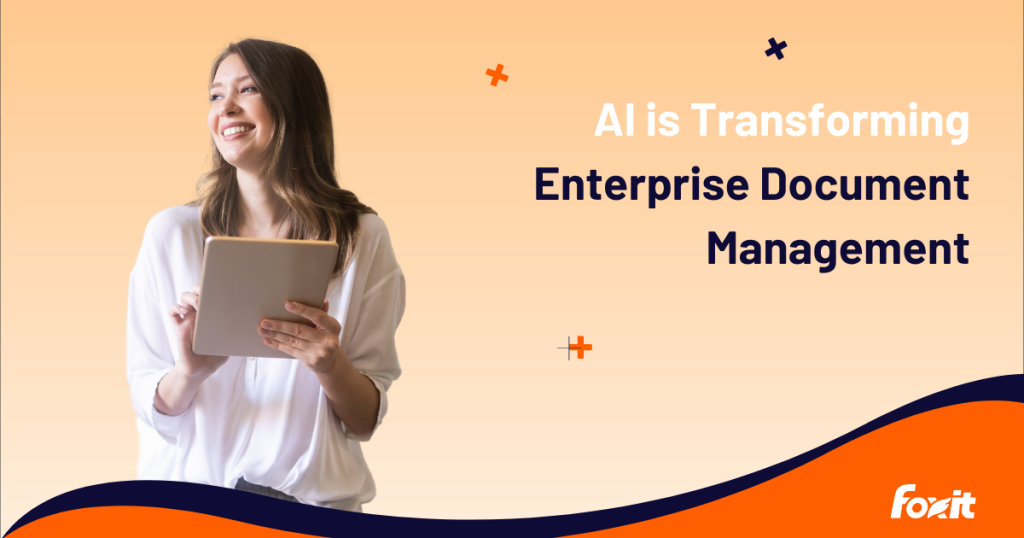- April 23, 2024
- FOXITBLOG

Unlike other choices, PDF format is platform-independent, and its relatively small file size makes documents easier to download, store, and transfer. Given today’s ceaseless flow of information, it’s crucial to process documents effectively. The good news is that advancements in artificial intelligence (AI) have laid the groundwork for much greater efficiency. Foxit, a renowned Software as a Service (SaaS) company, offers innovative solutions for PDF and eSign management.
Read on to explore the transformative role of AI in revolutionizing the process of document management, with a particular focus on PDFs:
How AI is reshaping PDF handling
Working with PDFs ,traditionally, is often viewed as tedious. That being said, consistently evolving, high-powered AI technology can speed up PDF management tasks such as data simplification, processing, and extraction. These optimizations leverage several technologies:
Natural Language Processing (NLP) for semantic understanding and text analysis
Data analysis results can empower more informed decisions. However, extracting conclusions can be overwhelming, especially if you’re handling large volumes of PDFs. NLP automates data analysis, making it much easier to identify what’s valuable. NLP not only clarifies processed data’s meaning and provides context, it also employs methods designed to determine intent. This is crucial in situations where you might need language translation or sentiment analysis.
Machine Learning (ML) for data extraction and categorization
In modern business environments, the substantial volume of documents processed is overwhelming. Machine learning algorithms streamline the procedure, extracting vital data — dates, names, contact information — and categorizing it based on both their training directives and predefined criteria.
Optical Character Recognition (OCR) for transcribing
Regardless of its original content, a scanned PDF is essentially an image. This means that the data within it isn’t readily accessible for copying or editing as it would be in a standard document. However, OCR can identify and interpret information embedded within images and transcribe it into editable and searchable text.

Advantages of AI-powered document management solutions
Implementing and utilizing AI-powered tools for PDF document management has many benefits. These include:
Improved accuracy in data extraction
Mistakes are bound to happen when manually transcribing data from PDFs, and this can lead to costly losses for your business. For instance, if a transcription error in a financial document goes unnoticed, it could lead to erroneous calculations or misinterpretations of key metrics. Such mistakes may result in inaccurate forecasts, incorrect billing, or regulatory compliance issues, potentially leading to penalties, reputational damage, and loss of investor trust.
Processing tools for AI documents automatically validate extracted data against predefined rules to ensure its accuracy. Since AI solutions work tirelessly around the clock, they also help reduce human errors due to boredom or fatigue.
Enhanced security measures
Manual processing, particularly in financial institutions and departments, is highly susceptible to fraud. AI tools offer a solution by detecting and mitigating fraud by eliminating human data manipulation, a common element in fraudulent activity. Additionally, AI tools validate all extracted data, reducing the risk of fraud by ensuring that any information moving forward is accurate.
Time and cost savings
The more time your organization spends on manual document processing and management, the more money it loses. Moreover, in cases where there are large volumes of documents, your enterprise may need to hire additional or temporary staff. Using AI document processing tools can help save your enterprise thousands, if not millions, by slashing data extraction time and reducing the need to hire more staff. AI tools also free up time for data management employees to focus on other revenue-generating tasks.
Scalability
Relying on manual approaches can be risky when dealing with large volumes of documents due to potential human errors, delays, and inconsistencies. With AI document processing tools, however, you can easily pull and analyze data from multiple documents, ensuring accuracy and consistency throughout the process.
Best Practices for Leveraging AI in PDF Document Management
Sure, implementing AI document processing solutions for PDFs can give your enterprise a competitive advantage, especially in a highly competitive world. However, as with any strategy, you must implement it carefully to get the best possible results. Here are some examples of AI PDF document management best practices:
Choose a solution tailored to your needs
Effectively implementing AI document management for PDFs hinges on selecting the right solution for your business. Conducting a thorough needs analysis will help you tailor a meaningful and effective game plan. Keep in mind that no matter how good a solution seems — if it doesn’t fulfill your data management needs, it’s useless.
Think about factors such as the volume of PDF documents, workflow, and budget constraints, along with scalability and data security requirements. By prioritizing alignment with your organization’s needs, you can make an informed choice that maximizes the benefits of AI document management.
Test before committing fully
Once you settle on one or several solutions, you won’t know they meet your needs 100% until you see them in action. It’s best to conduct a few tests before signing up for a paid option — bonus points if you get a free trial. Involving your enterprise’s relevant stakeholders during the testing phase can help you assess how effectively the solution meets its needs. Consider how well the solution integrates with existing systems, how comfortable your staff is with using it, and how scalable it is. Also, make sure that you’re comfortable with the accuracy of its data extraction.
Ensure data quality
Since AI ensures accurate data processing and organization, it’s your job to supply high-quality data. The saying “garbage in, garbage out” holds true here. Ensure PDF documents contain legible text and images with minimal noise or distortion, along with consistent formatting. To achieve this, you should invest in preprocessing techniques like image enhancement and text normalization before inputting the system data.
Stay updated with AI advances in document management
AI technology is advancing rapidly. Due to emerging technologies or evolving requirements, a solution that meets your document management needs today may not suffice in the future. Staying informed about technological advancements in the industry is crucial to maintaining a competitive edge. By staying abreast of new developments, you can adapt and optimize your document management strategies to stay ahead of the competition.

Case study: Kazan Law and Foxit PDF editor
The legal sector’s sheer volume of documents makes it a prime candidate for AI document processing and management solutions. Take, for instance, the Kazan, McClain Satterley & Greenwood law firm, which deals with large volumes of e-filings in PDF format.
Before implementing Foxit PDF Editor, Kazan Law experienced numerous challenges with its existing setup — from high licensing costs to inadequate support and resistance to interface changes. After searching and exploring several options, it ultimately settled on Foxit PDF Editor due to its user-friendly interface and critical features such as redaction and fill & sign.
Since adopting this solution, Kazan Law has reported several significant benefits:
- Cost savings and flexible licensing: Transitioning from Adobe Acrobat to Foxit PDF Editor resulted in reduced licensing costs for Kazan Law. By avoiding the complexities of subscription models and retaining perpetual licensing, the firm achieved flexibility and cost-effectiveness in managing licenses for all staff members.
- Increased productivity for minimal investment: Foxit’s intuitive user interface made its adoption at Kazan Law seamless, requiring minimal training. Staff members found Foxit’s PDF editor nearly custom-tailored to their needs, particularly appreciating features like the “Tell me what you want to do” box. All told, Foxit’s editor helped foster heightened productivity across the board.
- Reduced malpractice risks: As a plaintiff’s law firm dealing with sensitive medical records, Kazan Law recognizes the paramount importance of security in the legal industry. Ensuring that redacted documents don’t inadvertently expose confidential client information is critical to avoiding malpractice claims. Foxit’s effective redaction capabilities have safeguarded the firm against such risks by ensuring thorough and accurate redaction of all documents processed through its system.
- Exceptional support: Before Kazan Law transitioned to Foxit PDF Editor, Adobe Acrobat’s high licensing cost made maintenance and support expenditures prohibitive. Kazan Law reported using Google and assorted forums as a kind of makeshift support during its Acrobat days. With the Foxit editor in place, the firm experienced responsive and accelerated customer support during implementation and beyond.
Foxit PDF Editor: Your gateway to efficient document management
By integrating AI technology into PDF document management, your enterprise can unlock its full potential — streamlining workflows, enhancing efficiency, and fortifying against risks. The benefit potential is immense. With a solution like Foxit PDF Editor, you not only save time and resources but also gain a competitive edge in today’s fast-paced and dynamic market. Don’t wait — start your free trial today and witness the transformation firsthand.